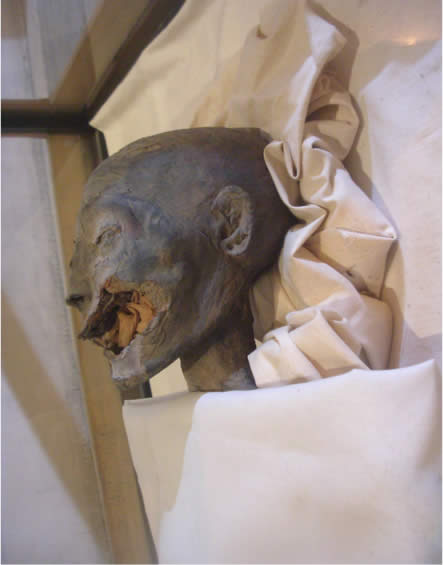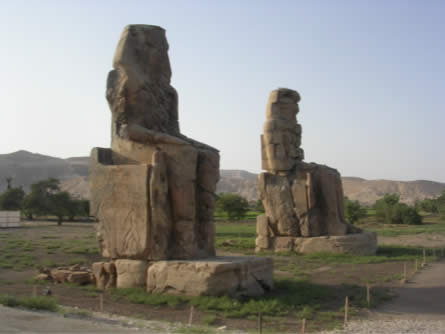Dr. Joann Fletcher
Exactly a year ago in September 2010, Dr. Stephen Buckley and I were invited to Cape Town as guests of the Egyptian Society of South Africa. During our stay we gave lectures about ‘the Search for Nefertiti’ and ‘Recent DNA studies of Tutankhamen and his family’, and gave a radio broadcast for SAfm, an interview to ‘Die Burger’ and a presentation at Stellenbosch University.
In each case we were able to explain the nature of our ongoing research, which has progressed over the last 12 months to reveal significant information about how the royals of the 18th dynasty were mummified. As a continuation of our work on three royal mummies from tomb KV.35 in the Valley of the Kings, these current findings have also been filmed, in locations ranging from the laboratories at the University of York to various sites around Egypt.
Yet our most recent visit to Egypt in early July coincided with a resumption of political demonstrations, when tens of thousands of people set up camp in Tahrir Square in front of the Cairo Museum. With the museum our first port of call, we were certainly anxious to find out how it had been affected in the January uprising, when images in the media showed armed forces tracking down thieves who had allegedly broken into the museum to steal various items. So we were very much relieved to find the museum itself apparently unscathed, and the items reported as stolen safe within their cases.
As the peaceful demonstrations continued outside the museum, all was strangely quiet within, the absence of the usual crowds allowing us to take our time over items of particular interest. These ranged from the burial equipment of Yuya and Tuya from their tomb in the Valley of the Kings to the colossal dyad of Amenhotep III and Queen Tiye which once stood in their funerary temple at Kom el-Hetan. We also studied some of the artefacts found in the burial chamber of Tutankhamen, such as the set of magical oars and the pair of Anubis fetishes, usually dismissed as ‘esoteric’ items of inexplicable purpose yet when studied alongside Howard Carter’s original notes and plans they reveal clues about the funerary processes of this very unusual period, when even mummification was undertaken in a very particular way.
Following several hours in the Royal Mummy room filming with Amenhotep II and Tuthmosis IV, we concluded our visit by tracking down three further royals whose bodies had been placed together in a side corridor. These were the skeletal remains from KV.55, brought out of museum storage and now labelled as Akhenaten, and the two female mummies brought to the museum from the side chamber of KV.35, the older of the two labelled as ‘Queen Tiye’ and the younger, designated ‘the wife of Akhenaten’, left unnamed.

Although we had suggested to the Egyptian authorities that this mummy might be that of Nefertiti back in 2003, they had initially claimed that the body was that of a teenage girl, until they undertook the first of a series of DNA tests which apparently revealed the body was male. Then as part of a more ambitious study in 2010, the same authorities undertook further DNA tests, which this time revealed the body was female, a fact confirmed by the presence of the female genitals noted by the anatomist Grafton Elliot Smith in his 1912 catalogue ‘The Royal Mummies’. This landmark publication has now been updated by Egyptian mummy expert Ahmed Saleh, the first director of Luxor’s Museum of Mummification, who states our theory is based on a wide range of evidence and concludes that the mummy of the so-called ‘Younger Woman’ is indeed that of Nefertiti.
Following our time in Cairo, we then flew south to Luxor in order to pursue investigations at one of the most important yet rarely credited sites connected to the history of mummy studies – the Winter Palace Hotel! Standing on the banks of the Nile beside Luxor temple, the place where the pharaohs of the New Kingdom annually recharged their spiritual powers, the Winter Palace was the base from which Carter and his patron Lord Carnarvon had undertaken their excavation of the tomb of Tutankhamen in 1922.
In 1968 the famous hotel had continued to play its part in the story when it became the base for a second wave of experts, led by British anatomist R.G. Harrison. Accompanied by a BBC film crew, Harrison’s team X-rayed the king’s mummified body within his burial chamber, but whereas we had been able to use portable digital X-ray equipment in our own work in the valley in 2003, the 1968 team were working with traditional x-ray film, their test exposures developed in the nearest available facilities they described as “the commodious bathroom furniture” of the Winter Palace hotel.
With the help of the hotel’s very helpful staff, including one long-serving member who even remembered the event, we were able to pinpoint the very bathroom in which the famous Tutankhamen X-rays had first been produced. Not only revealing an unusual fragment of bone in the king’s skull cavity which initiated long-running speculation as to his apparent cause of death, these same X-ray images revealed that the king had been mummified in the same distinctive manner as his illustrious grandfather Amenhotep III, the self-styled ‘Dazzling Aten’ whose mummified remains reveal the same unusual treatment, including the lavish application of golden resins.
Although the likely location for each monarch’s mummification was the funerary temple created for each of them on Thebes’ west bank, the largest of these temples was created for Amenhotep III at Kom el-Hetan. An enigmatic site which has fascinated us since our first visit in 1981, the site is best known for the so-called Colossi of Memnon, the pair of huge statues of Amenhotep which originally flanked the first pylon of a massive temple stretching back toward the foot of the Theban hills.

For many years the Colossi were accompanied by little more than one of the king’s large stelae and the column bases of a vast peristyle court, mirroring that of Luxor temple on the opposite river bank. By the 1990s however, water from the irrigation of neighbouring fields had started to encroach the temple, twice listed as one of the world’s 100 most endangered sites by the World Monuments Fund. This led to the creation of several fund-raising groups, including the ‘Association des Amis de Memnon’, ‘Förderverein Memnon’ and the UK-based ‘Friends of the Colossi’, all of which raised funds for a series of water pumps to drain various parts of the site and allow an extensive programme of excavation and conservation to begin in 1998.
Led by Dr. Hourig Sourouzian and her team, their patient work has been gradually bringing the temple out of the earth which covered much of it over, for despite earthquake damage in ancient times, much of the site’s current obscurity is largely due to its low-lying position which allowed the waters of the annual Nile floods to cover the site and deposit silt as they receded. Not only is this plainly visible in 19th century paintings and old photographs, the king’s own building inscriptions state that the temple’s “waters are filled by Hapy, the Great Inundation”, Hapy’s plump figure emulated in statuary of the king as a means to emphasise the fertility he brought to his people.
Yet with the whole West Bank at his disposal, Amenhotep III had clearly selected this low-lying site for a specific reason, presumably to incorporate the annual flood whose receding waters would perhaps make the temple appear to rise up, imitating of the mound of creation appearing from the waters at the beginning of time. And although we were initially unsure as to how they achieved this, we were privileged to be taken on a tour of the site by Dr. Sourouzian herself, who revealed that a large channel or canal connected to the Nile may have originally surrounded the entire site, effectively creating an island on which the king’s temple had been built.
Given that the purpose of this temple was to sustain the king’s soul for eternity, there may have been some attempt to harness the powers of the life-giving flood whose ability to restore life to the land might have been extended to the king’s own funerary rites. Certainly the king’s desire to bring the Nile waters so close to the Theban hills was apparent as early as 1974, when archaeologists working at Amenhotep’s nearby palace at Malkata noted that “the king, …large expanses of water, the pre-eminence of the sun over all forms of life, all seem linked in some way”.
So as the current excavations literally resurrect Amenhotep III’s legacy from the site of his once great funerary temple, the secrets of mummification from this whole golden age are similarly being brought to light following the application of the cutting-edge science described in the second part of this article.
Dr. Joann Fletcher is a Teaching and Research Fellow at the University of York and Egyptology Consultant to Harrogate Museums and Arts. As a founder member of the University of York’s Mummy Research Group she has studied human remains around the world, and lectures widely on the subject.
Anyone interested in supporting the work of Dr. Sourouzian can contact the UK-based ‘Friends of the Colossi’ administered by the Horus Egyptology Society: http://www.horusegyptology.co.uk/
Further Reading:
J.E. Harris et al. 1978, Mummy of the ‘Elder Lady’ in the tomb of Amenhotep II: Egyptian Museum Catalog Number 61070, Science 200, p.1149-1151
A. Saleh, 2010, The Royal Mummies, Cairo (Middle East Co.)
G. Elliot Smith, 1912, The Royal Mummies: Catalogue General des Antiquites Egyptiennes de la Musee du Caire, Nos. 61051-61100, Cairo (republished as ‘The Royal Mummies’ by Duckworth, 2000)
J. Fletcher, 2004, The Search for Nefertiti, London (Hodder & Stoughton)
B. Kemp & D. O’Connor, 1974, An Ancient Nile Harbour: University Museum Excavations at the Birket Habu, International Journal of Nautical Archaeology and Underwater Exploration 3, No. 1 (March 1974), p. 101-136
